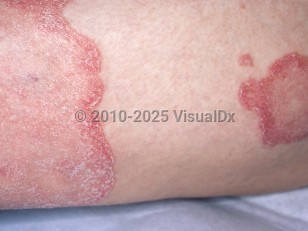Pustular psoriasis may occur in children but is more commonly seen in middle-aged adults. It is also found more frequently in Asian and Hispanic individuals than in White individuals. Some patients with a history of plaque psoriasis can develop pustular psoriasis, but the two conditions appear to have distinct genetic and pathophysiologic mechanisms.
The etiology of pustular psoriasis is incompletely understood, but cases have been associated with hypocalcemia, infection (Trichophyton rubrum, cytomegalovirus, Streptococcus spp, varicella-zoster virus, and Epstein-Barr virus), a rapid withdrawal of corticosteroids, pregnancy, medications (NSAIDs, lithium, potassium iodine, trazodone, penicillin, interferon, and hydroxychloroquine), and topical irritants such as tar and anthralin. While tumor necrosis factor (TNF)-alpha antagonists such as infliximab and adalimumab are used to treat pustular psoriasis, they have also been reported paradoxically to induce it.
Additionally, there is emerging evidence that pustular psoriasis is associated with mutations in the IL36RN gene that encodes the interleukin-36 receptor antagonist (IL-36RA). Mutations in this gene have been detected in different variants of pustular psoriasis, including generalized pustular psoriasis, pustular psoriasis of pregnancy, palmoplantar pustulosis, and the exanthematic type of pustular psoriasis. Deficiency of interleukin-36 (IL-36) receptor antagonist (DITRA) syndrome is an autoimmune inflammatory disorder caused by loss of function mutations in the IL36RN gene that manifests in early childhood with generalized pustular psoriasis, fever, leukocytosis, and elevated C-reactive protein (CRP) levels.
There are 4 subtypes of pustular psoriasis:
- von Zumbusch type (generalized pustular psoriasis) – Acute onset of generalized erythema and pustules with systemic manifestations including fever, skin tenderness, malaise, arthralgias, headache, and nausea. After several days, the pustules resolve to become confluent, scaling plaques.
- Exanthematic type – Acute onset of small pustules that are triggered by an infection or a drug. This subtype usually lacks systemic symptoms.
- Annular subtype – Erythematous, annular lesions that have pustules at the advancing edge of a lesion and is associated with fever, malaise, and other systemic manifestations. The annular variant is the most common form of pustular psoriasis in children.
- Localized pattern – Pustules appear in existing psoriatic plaques. This can be seen in active plaques. Palmoplantar pustular psoriasis is the most common form of localized pustular psoriasis. Localized pattern also includes acrodermatitis continua of Hallopeau, in which the distal digits are primarily involved.
Patients may experience relapses and remissions over a period of years. It may be precipitated by use and withdrawal from systemic corticosteroids.
Extracutaneous manifestations of pustular psoriasis may be severe. The most common extracutaneous manifestations of pustular psoriasis include cholestasis, cholangitis, arthritis, intestinal pneumonitis, oral lesions, and acute renal failure. Electrolyte disturbances such as hypocalcemia may occur and can be life-threatening. Lesions may also become superinfected.
Note: Only in rare cases, such as severe pustular psoriasis or pustular psoriasis of pregnancy, should oral steroids be considered. The use of systemic steroids will lead to severe psoriasis rebound after steroid discontinuation.



